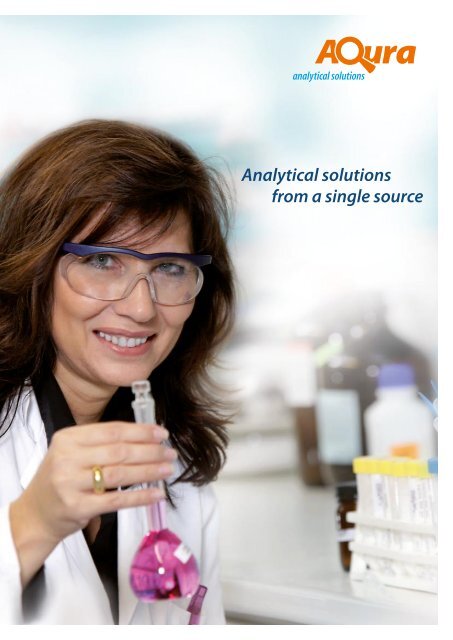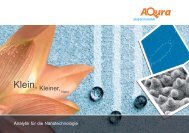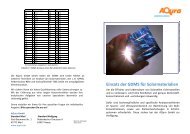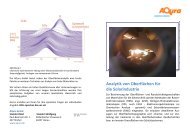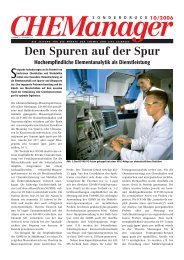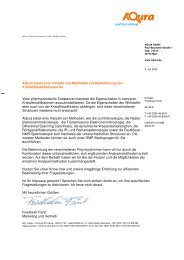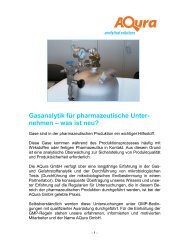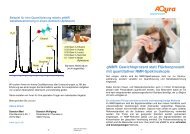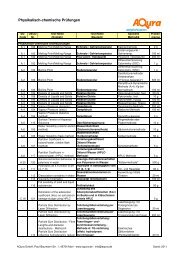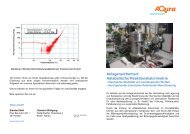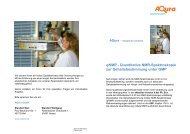Analytical solutions from a single source - Aqura Gmbh
Analytical solutions from a single source - Aqura Gmbh
Analytical solutions from a single source - Aqura Gmbh
You also want an ePaper? Increase the reach of your titles
YUMPU automatically turns print PDFs into web optimized ePapers that Google loves.
<strong>Analytical</strong> <strong>solutions</strong><br />
<strong>from</strong> a <strong>single</strong> <strong>source</strong>
Techniques & procedures<br />
04 - 05 Quality standard<br />
Development priorities<br />
06 - 07 Inorganic analytics<br />
Chromatography<br />
08 - 09 Computational Chemistry<br />
Mass spectrometry<br />
10 - 11 Microscopy<br />
Molecular spectroscopy<br />
12 - 13 Surface and interface analytics<br />
Organic analytics<br />
14 - 15 Physical substance data<br />
Biochemical analytics<br />
16 -17 Safety testing<br />
Environmental measuring methods<br />
18 - 19 Management team<br />
Certifications<br />
“Thank you for the very good<br />
cooperation and helpful<br />
discussions.”<br />
“I thank you for the<br />
unsurpassed fine cooperation<br />
with you; not only for your<br />
professionality but also for the<br />
kindness and the collegiality ...”<br />
Customer satisfaction analysis 2010<br />
What do you expect <strong>from</strong> a company which provides<br />
analytical services with the greatest of care and<br />
precision?<br />
For example the ability to use a wide variety<br />
of methods? Always being one step ahead<br />
of the competition? Certainly a corporate<br />
culture which is based on a permanent dialogue<br />
and working together as partners, as<br />
well as an experienced and motivated team<br />
which solves all problems with farsightedness<br />
and expertise.<br />
With our techniques and methods we have<br />
been serving many sectors for years. Our<br />
attention is strongly focused on the fields of<br />
chemistry, pharmaceutics, biotechnology<br />
and materials science. The analyses perfor-<br />
med by us, their results and the information<br />
obtained <strong>from</strong> them are of course treated<br />
confidentially.<br />
Range of services<br />
In our laboratories we offer analytical services<br />
in the fields of research, process development,<br />
product development, application<br />
technology, production and plant safety.<br />
The basis for this is a wide range of modern<br />
methods and techniques, as well as a large<br />
number of validated procedures which we<br />
have developed ourselves.<br />
We are specialists in the following sectors:<br />
• Special chemistry<br />
• Pharmaceutical industry and<br />
biotechnology<br />
• Materials science<br />
02 - 03
Quality standard<br />
Experience<br />
Sometimes it seems to us that the world<br />
turns a little faster every day. For industrial<br />
companies it is true more than ever that the<br />
time available for making accurate decisions<br />
with far-reaching consequences is becoming<br />
shorter and shorter.<br />
In this situation, it is a relief to have a reliable<br />
and experienced partner at one’s side who<br />
perfectly knows his trade and can really help.<br />
Development priorities<br />
Aims<br />
Our priorities include developing, evaluating<br />
and testing new analytical methods on<br />
large scale equipment and special analytical<br />
techniques.<br />
The aim is to make the necessary methods<br />
available and utilisable at an early stage<br />
through systematic transfer of knowledge.<br />
Here, the main focus is on a greater degree<br />
of selectivity and detection sensitivity,<br />
greater speed and – to a certain extent –<br />
completely new interpretation possibilities.<br />
Quality<br />
Our testing institute guarantees a high<br />
level of quality for all analyses. Our quality<br />
standards have been recognised by various<br />
independent bodies.<br />
Regular participation in round robin tests<br />
is as self-evident for us as the continual<br />
checks of our methods.<br />
Confidentiality<br />
It goes without saying that the analyses<br />
performed by us, their results and the<br />
information obtained in this connection<br />
are treated confidentially.<br />
Upon request additional confidentiality<br />
agreements can be concluded.<br />
Examples<br />
• Development of new tools and<br />
applications <strong>from</strong> computational<br />
chemistry / molecular modelling<br />
• Modern electron microscopic and<br />
spectroscopic processes for charac-<br />
terising surfaces (e.g. scanning probe<br />
methods, molecule detection down<br />
to the ppb range)<br />
• New mass spectrometric techniques<br />
and coupling techniques for high<br />
throughput and bioanalytics to<br />
supplement high-throughput<br />
screening, proteome research and<br />
biocatalytic developments<br />
Processing time<br />
We guarantee the fastest possible processing<br />
of the samples around the clock, according to<br />
schedule and in line with your requirements.<br />
Depending on the type of technique<br />
employed, this may also be possible within<br />
one day.<br />
Services<br />
Our services are extensive and highly<br />
specialised. For particularly urgent cases,<br />
we offer an express service and sample<br />
collection service.<br />
We come to you, fetch and return the<br />
samples. Reliably and fast.<br />
“AQura stands out due to<br />
their high scientific level and<br />
excellent experts ...”<br />
“ ... what should be emphasised<br />
is the sustainability of their<br />
customer care before, while and<br />
following the actual order ...”<br />
Customer satisfaction analysis 2010<br />
04 - 05
Inorganic analytics<br />
Qualitative and quantitative element<br />
determination in the total sample<br />
• AAS: Flame, graphite furnace, hydride<br />
generation, cold vapour atomic absorption<br />
spectroscopy<br />
• ICP-OES: Optical emission spectroscopy<br />
with inductively coupled plasma<br />
• ICP-MS: Elemental mass spectrometry<br />
with inductively coupled plasma, high<br />
and low resolution, ultra-trace analysis,<br />
individual element and screening analysis,<br />
CE, LC-ICP-MS coupling<br />
• GD-MS: Multi-element analysis,<br />
elemental survey analysis<br />
• XRF: X-ray fluorescence analysis,<br />
quantitative and qualitative individual<br />
elements, qualitative overview analysis,<br />
semi-quantitative XRF with fundamental<br />
parameter evaluation<br />
• Volumetry, gravimetry, electrogravimetry<br />
• Photometry<br />
Chromatography<br />
Gas chromatography<br />
(GC)<br />
• Various detectors such as flame ionisation,<br />
thermal conductivity, mass spectrometry,<br />
photometry, electron capture, etc.<br />
• Various injection techniques such as oncolumn,<br />
cold injection, thermodesorption,<br />
etc.<br />
• Gases and liquefied gases<br />
• Gas samples, also under GMP<br />
• Pressure gas analytics for the pharmaceutical<br />
industry (identity, composition,<br />
oil traces, particle content)<br />
• GC after derivatisation<br />
• From the headspace<br />
(headspace GC, purge & trap GC / MS)<br />
• High-temperature GC<br />
• Separation of enantiomers<br />
• Pyrolysis GC / MS<br />
• Titrations (complexometric, acid / base,<br />
potentiometric, redox, argentometric)<br />
• Ion-sensitive electrodes<br />
• Ion-chromatography, quantitative deter-<br />
mination of halides, anions and cations<br />
• Combustion analyses,<br />
elemental analyses in inorganics<br />
(determination of C, H, N, O and S)<br />
• Ash determinations,<br />
ignition and drying losses<br />
High-performance liquid<br />
chromatography (HPLC)<br />
• Various separation selectivities such as<br />
reversed phase, normal phase, ion exclusion,<br />
ion pair chromatography, etc.<br />
• Various detectors such as UV, diode array,<br />
fluorescence, refractive index, mass<br />
spectrometry, conductivity, light diffusion,<br />
nitrogen-selective, etc.<br />
• Pre-column and post-column derivatisation<br />
• Separation of enantiomers, analytical<br />
racemate separation, determination of<br />
enantiomeric purity<br />
• Preparative isolation of pure enantiomers<br />
Elements on surfaces and<br />
in thin layers<br />
• GD-MS: Glow discharge mass spectrometry<br />
• Surface analytics, microscopy, X-ray micro-<br />
analysis (EDX)<br />
XRD crystalline phase analysis<br />
• XRD: Qualitative and quantitative phase<br />
analysis<br />
• X-ray crystallite size determination<br />
• Determination of lattice parameters<br />
• Texture determination (statement on<br />
textures / preferred orientations)<br />
• Rietveld refinement<br />
(structural methods, quantitative analysis)<br />
• Polymorph determination<br />
• Small-angle scattering (SAXS) for the<br />
determination of primary particle sizes<br />
• Micro-preparative and preparative<br />
isolation of unknown secondary<br />
components <strong>from</strong> products or product<br />
blends (identification, purification,<br />
characterisation of reference material)<br />
• ASA, amino acid analysis, qualitative and<br />
quantitative amino acid determination,<br />
trace determinations, amino acid analytics<br />
after hydrolysis (e.g. for peptide<br />
quantification and characterisation)<br />
Gel permeation chromatography<br />
(GPC)<br />
• GPC with RI and UV detection<br />
• Absolute molar mass and molar mass<br />
distribution according to gel chromatography<br />
and MALS detection<br />
• Molar mass fractions, preparative<br />
isolation, oligomer and polymer content<br />
determination in organic monomers and<br />
pharmaceutical active substances<br />
Ion chromatography<br />
(IC)<br />
• Determination of inorganic and / or<br />
organic anions and cations (including<br />
carbohydrate analytics)<br />
• Besides the standard forms of detection<br />
in HPLC, conductivity detection (with<br />
and without suppression techniques)<br />
and electrochemical detection are used<br />
Capillary electrophoresis<br />
(CE)<br />
• Direct and indirect UV detection, diode<br />
array<br />
• Capillary zone electrophoresis (CZE) and<br />
micellar electrokinetic chromatography<br />
(MEKC)<br />
• Separation of enantiomers<br />
• Isotachophoresis<br />
Info<br />
In chromatography, the selective analysis<br />
of individual components in a mixture is<br />
performed through the physical separation<br />
of the individual components.<br />
Thin-layer chromatography<br />
(TLC)<br />
• Qualitative, semi-quantitative and<br />
quantitative determination of purity,<br />
main and secondary components<br />
• Preparative separation, semi-quantitative<br />
and quantitative determination of<br />
enantiomeric purity<br />
• Preparative separation of substances or<br />
substance blends, pure isolation of<br />
secondary components <strong>from</strong> product<br />
blends<br />
Element speciation<br />
• Photometry<br />
• HPLC-ICP-MS coupling<br />
06 - 07
Computational chemistry<br />
Molecular simulation (quantum chemistry,<br />
force fields and statistical methods)<br />
• Molecular and crystalline structures<br />
• Crystal morphology<br />
• Chemical reactions, catalysis,<br />
surface processes<br />
• Substance data<br />
• Polymer characteristics<br />
• Structure-property relationships<br />
• Reaction kinetics, molecular dynamics<br />
• Phase equilibria<br />
• Solubility<br />
Mass spectrometry<br />
General mass spectrometry<br />
• Ionisation techniques: Electron impact (EI),<br />
chemical ionisation (CI), electrospray (ESI),<br />
nano-ESI, atmospheric pressure chemical<br />
ionisation (APCI)<br />
• Positive and negative ions<br />
• Low-resolution analysers (ion traps,<br />
quadropole, time-of-flight)<br />
• High Mass resolution with Fourier-transform<br />
ion cyclotron resonance mass spectrometry<br />
(FT-ICR) and orbitrap technology<br />
• Multi-dimensional mass spectrometry<br />
(MS-MS, MSn)<br />
• Accurate masses for determining elemental<br />
composition / empirical formula<br />
Coupling techniques<br />
• Direct evaporation<br />
• Coupling with gas chromatography (GC)<br />
• Static/dynamic headspace GC-MS<br />
(HS-GC-MS)<br />
• Thermodesorption GC-MS (TD-GC-MS)<br />
• Pyrolysis GC-MS<br />
• Liquid chromatography (HPLC,<br />
micro-HPLC, nano-HPLC, UPLC)<br />
• Ion chromatography (IC-MS)<br />
• Gel permeation / size exclusion<br />
chromatography (GPC/SEC-MS)<br />
• HPLC ICP MS for elemental speciation<br />
Info<br />
Mass spectrometry enables the identification<br />
and quantification of individual components<br />
in complex substance mixtures. The high<br />
level of detection sensitivity allows statements<br />
to be made at trace concentration level.<br />
Quality problems with products are clarified at<br />
the molecular level with mass spectrometry.<br />
Special techniques<br />
Info<br />
• MALDI-TOF-MS<br />
Wir nutzen bei spektroskopischen<br />
• Analysis of technical polymers and<br />
Struktur-Untersuchungen umfangreiche<br />
biopolymers<br />
Datenbanken.<br />
• Qualitative and quantitative proteomics<br />
Zur Strukturaufklärung und Identitätsprüfung<br />
• Enzymatic führen digestion wir auch analytics kombinierte Arbeiten<br />
mit spektroskopischen<br />
• Identity and purity tests of proteins<br />
Methoden (NMR, IR, Raman, UV etc.) nach<br />
Reindarstellung • High-throughput von screening Substanzen (HTS) mit der<br />
präparativen<br />
• High-throughput<br />
HPLC oder<br />
quantification<br />
GC durch.<br />
with<br />
SRM techniques<br />
• LC-MS on chiral phases<br />
• LC-MS with N-selective<br />
chemiluminescence detector<br />
08 - 09
Microscopy<br />
Electron microscopy<br />
• Scanning electron microscopy (SEM) and<br />
field emission scanning electron microscopy<br />
(FE-SEM) with various sample preparation<br />
techniques, including (cryo-) microtomy,<br />
embedding, grinding, polishing, cryofracture,<br />
selective etching<br />
• Transmission electron microscopy (TEM)<br />
with various sample preparation techniques,<br />
including (cryo-) ultra-microtomy,<br />
contrasting methods<br />
• Energy dispersive X-ray analysis (EDX)<br />
in SEM (microanalysis) and TEM<br />
(nanoanalysis)<br />
• Electron energy loss spectroscopy (EELS)<br />
in the TEM<br />
• Cryo-TEM<br />
Molecular spectroscopy<br />
NMR spectroscopy<br />
• Digital 400, 500 and 600 MHz NMR<br />
spectrometer<br />
• From 2012: Cryo probe technology for<br />
maximum sensivity of 1 H and hetero nuclei<br />
• Routine 1 H, 13 C, 29 Si and 31 P-NMR<br />
spectroscopy<br />
• Also other NMR-active hetero nuclei<br />
( 11 B, 27 Al, 119 Sn, 195 Pt, amongst others)<br />
• Determination of molecular structure and<br />
identity<br />
• Special pulse techniques, multi-dimensional<br />
NMR for structural elucidation<br />
• Content determination against certified<br />
internal standards (qNMR)<br />
• Measurements in accordance with GMP<br />
and GLP requirements on qualified<br />
spectrometers<br />
• Kinetic measurements, molecular dynamics<br />
• Solid state NMR (400 MHz), CP-MAS<br />
• <strong>Analytical</strong> TEM with maximum resolution<br />
(HR-TEM, 200 kV field emission, resolution<br />
down to 1.2 Angstrom), with STEM addition<br />
and HAADF detector<br />
• Electron diffraction, determination of<br />
lattice constants<br />
• Particle size distributions<br />
• Primary particle size determination<br />
(according to ASTM, using TGZ techniques)<br />
• Aggregate size distributions and<br />
classification analyses<br />
• Plasma preparation techniques<br />
• Digital image processing and<br />
documentation<br />
Optical microscopy<br />
• Optical microscopy (reflected/transmitted<br />
light, polarisation, hot stage, fluorescence)<br />
• Digital image processing and<br />
documentation<br />
• Laser-assisted surface profiling<br />
(2 and 3-D measurements)<br />
Infrared / Near-infrared spectroscopy<br />
(IR / NIR), Raman spectroscopy<br />
• Fourier transform infrared spectroscopy<br />
(FT-IR)<br />
• Measurements in accordance with GMP<br />
and GLP requirements on qualified<br />
spectrometers<br />
• Surface and micro-particle analysis with<br />
attenuated total reflection (ATR, diamond<br />
ATR, germanium ATR)<br />
• Reflection measurements with heatable<br />
DRIFT unit<br />
• Identity check using NIR spectroscopy<br />
• FT Raman spectroscopy with NIR excitation<br />
Spectroscopy in the ultraviolet and<br />
visible range (UV / Vis)<br />
• UV / Vis spectrometer scaning and<br />
diode array<br />
• UV / Vis remission measurements<br />
(reflection of powders and surfaces up<br />
to 1100 nm) UV/Vis applications with or<br />
without derivatisation, colour reactions<br />
and derivative spectroscopy<br />
• Spectroscopic determination of colour<br />
numbers (APHA, Gardner, yellowness<br />
index) etc.<br />
Info<br />
On the basis of their spectroscopic properties,<br />
molecules can be identified in a similar<br />
manner to a fingerprint.<br />
If unknown compounds such as undesirable<br />
impurities occur, the molecular structure<br />
is often determined by means of detective<br />
work using spectroscopy.<br />
In addition, the purity and the course of<br />
entire chemical reactions can be followed.<br />
10 -11
Surface, interface and<br />
depth profile analyses<br />
Solid matter surface analyses<br />
• X-ray photoelectron spectroscopy<br />
(XPS) / electron spectroscopy for chemical<br />
analysis (ESCA), monochromatised and<br />
non-monochromatised X-rays<br />
• Localised small spot XPS<br />
• Chemical XPS surface mapping, parallel<br />
imaging<br />
• XPS for determining the electrostatics of<br />
powders<br />
• Cryo-XPS<br />
• Ultraviolet photoelectron spectroscopy<br />
(UPS)<br />
• Residual gas and desorption mass<br />
spectrometry<br />
• In-situ reduction and / or temperature<br />
pre-treatment<br />
Organic analytics<br />
Chemical characteristics<br />
• Pharmacopoeial test<br />
(DAB, USP, BP, Ph.Eur., Ph. Helv., etc. )<br />
• Bromine, iodine, carbonyl, ester, hydroxyl,<br />
acid, base, saponification numbers<br />
• Epoxide, NCO, peroxide content<br />
• Determinations of water content<br />
(in solid, liquid, gaseous samples)<br />
• Residue of evaporation, residual moisture,<br />
dry and extract content<br />
• Ash, volatility<br />
• Pour point<br />
• Colour numbers, colorimetry, photometry<br />
(APHA, Gardner, Sayboldt, iodine, etc.)<br />
• Polarimetry (polarimeter, microcells,<br />
also heatable)<br />
• Secondary ion mass spectrometry<br />
(SIMS), static and dynamic<br />
• Secondary neutral particle mass<br />
spectrometry (SNMS)<br />
• Ion scattering spectroscopy (ISS)<br />
• Depth profile analyses by means of XPS<br />
and SIMS<br />
• Laser-assisted surface profilometer (2D<br />
and 3D measurements)<br />
Atomic force microscopy (AFM)<br />
• Determination of the surface roughness,<br />
contact mode, non-contact mode,<br />
tapping mode, phase contrast mode,<br />
nano-indentation<br />
Wet analyses, titrations<br />
• Neutralisation, precipitation and redox<br />
titrations, complexometry, potentiometry<br />
• Titration in non-aqueous media<br />
• Two-phase titration for surfactants<br />
• Water determination according to<br />
Karl-Fischer (coulometric and volumetric<br />
and oven technique)<br />
Characteristics of polymers<br />
• Carboxyl, amino, hydroxyl terminal group<br />
assay<br />
• Gel fraction, carbon black content, filler<br />
content<br />
• J-value, intrinsic viscosity, solution viscosity<br />
• Molar mass (relative), molar mass<br />
distribution<br />
• Water solubility<br />
• Residual monomers<br />
• Emissions<br />
• Polymer composition<br />
Photometry, UV/VIS spectroscopy<br />
• Anions, cations, stabilisers, aldehydes,<br />
phenols, tensides<br />
• Turbidity measurements, nephelometry<br />
• Spectroscopic determination of colour<br />
numbers (APHA, Gardner, yellowness<br />
index, etc.)<br />
• UV / Vis applications with / without<br />
derivatisation, colour reactions and<br />
derivative spectroscopy<br />
• UV / Vis spectrometer (recording and<br />
diode array), transmission and reflection<br />
measurements<br />
• Fluorescence spectroscopy<br />
Sorption analysis and porosimetry<br />
• Specific surface area (BET, STSA)<br />
• Fractal dimension (FHH, BET)<br />
• Analysis of micro- and mesopores by<br />
gas adsorption (micropores: t-plot,<br />
Horvath-Kavazoe, DFT / mesopores: BJH)<br />
• Mercury porosimetry<br />
• Determination of metal dispersion by gas<br />
chemisorption measurements (Pt, Pd, Rh,<br />
Ni, Cu, …)<br />
• Temperature-programmed desorption /<br />
reduction / oxidation (TPD / TPR / TPO)<br />
• Water vapour sorption (DVS)<br />
Combustion and elemental analyses<br />
• C/H/N/S/O determination<br />
• Oxygen determination in the high<br />
temperature furnace, also in metal / semimetal<br />
oxides and samples containing<br />
fluorine or phosphorus<br />
• Total sulphur, fluorine, chlorine, bromine,<br />
iodine by Wickbold digestion<br />
• Total inorganic carbon (TIC)<br />
• Organic carbon (TOC, DOC)<br />
• Total carbon (TC)<br />
• Total nitrogen and ammonium-nitrogen<br />
by Kjeldahl analysis<br />
Tensiometry and contact angle<br />
• Surface and interfacial tension of liquids<br />
(ring, plate, pending-drop, spinning<br />
drop methods)<br />
• Critical micelle concentration (CMC)<br />
• Contact angle (sessile drop),<br />
surface energies<br />
• Wettability/wetting effect on planar<br />
surfaces, fibres, powders<br />
Zeta potential<br />
• Zeta potential<br />
(electrophoretic light scattering,<br />
electroacoustics), titration curves<br />
Electrochemical procedures<br />
• Amperometry, dead-stop titrations<br />
• Conductometry, coulometry<br />
• Potentiometry<br />
(mass analyses, micro-pH)<br />
• Voltammetry, polarography<br />
Info<br />
Applying analytical techniques a balance<br />
for the chemical elements and functional<br />
groups can be drawn.<br />
Through combination with higher selective<br />
analytical procedures (separation methods,<br />
spectroscopy) it is possible to achieve a fundamental<br />
understanding of the composition<br />
of products on an organic chemical basis.<br />
12 -13
Physical substance data<br />
Particle size distribution<br />
• Laser diffraction spectroscopy<br />
(wet, dry dispersion)<br />
• Dynamic light scattering (DLS)<br />
• Single particle optical sizing<br />
• Sieve analysis (dry, wet, air jet sieving)<br />
• Dynamic image analysis<br />
Thermal analyses and calorimetry<br />
• Thermogravimetry (TG, thermal stability)<br />
• Differential scanning calorimetry (DSC)<br />
• Simultaneous thermal analysis (TG / DSC)<br />
• Simultaneous thermal analysis with evolved<br />
gas analysis (EGA) by coupling with mass<br />
spectro metry and infrared spectrometry<br />
(TG / DTA-MS-FTIR)<br />
• Temperature programmed desorption /<br />
reduction / oxidation (TPD / TPR / TPO)<br />
• Isothermal reaction calorimetry<br />
Biochemical analytics<br />
Gel electrophoresis<br />
• Isoelectric focussing (IEF)<br />
• SDS-page, 2D gel electrophoresis with<br />
different staining techniques and image<br />
analysis<br />
• Western blot for protein with specific<br />
antibody detection<br />
Enzyme immunoassays<br />
• ELISA techniques<br />
“Bio-specific” NMR and MS Methods<br />
• Proteomics<br />
• Sequence analyses on polypeptides /<br />
proteins<br />
• Quantitative and qualitative metabolomics<br />
Protein and DNA analytics<br />
• Capillary electrophoresis<br />
• Protein determination according to<br />
Bradford (colorimetric)<br />
• Protein digestion<br />
• Endotoxin determination (LAL test)<br />
• Fluorometric double-stranded (ds) DNA<br />
determination<br />
Field-flow fractionation<br />
• Characterisation of biopolymers, determination<br />
of mean molecular weights,<br />
radii of gyration<br />
Electrical properties<br />
• Surface and volume resistivitiy<br />
(films, plates, layers)<br />
• Dielectric constant, permittivity<br />
(liquids, films)<br />
• Breakdown voltage<br />
• Conductivity (aqueous <strong>solutions</strong>)<br />
Rheology and viscosity<br />
• Rotation and oscillation measurements<br />
(flow curves, yield point, viscoelastic<br />
behaviour, structure)<br />
• Capillary viscosimetry<br />
• Viscosity index, K value,<br />
molecular weight determination<br />
Physical and other characteristics<br />
• Density (liquids: pycnometer, oscillating<br />
densimeter; solids: pycnometer,<br />
gas pycnometer, buoyancy method)<br />
• Bulk density, tapped densitiy<br />
• Powder flowability<br />
(angle of repose, flow index, Hausner ratio)<br />
• Melting point<br />
(capillary method, DSC, hot stage<br />
microscope)<br />
• Freezing point<br />
• Pour point, cloud point<br />
• Boiling point (ebulliometer, DSC)<br />
• Distillation range<br />
• Vapour pressure<br />
(static, dynamic method, vapour pressure<br />
balance)<br />
• Solubility measurements<br />
• Surface tension<br />
• Refractive index<br />
• Thermal conductivity (solids, powders,<br />
liquids)<br />
• Specific heat<br />
• Calorific value, heating value<br />
• Water activity (Aw),<br />
water vapour sorption (DVS)<br />
• Zeta potential of dispersions<br />
• Permeability of films / glove testing<br />
• Particulate contamination<br />
• Air-release/water separability of oils<br />
• Oxidation stability of oils<br />
Info<br />
Physical measurements provide essential<br />
information for the characterisation of<br />
substances and materials.<br />
Both in the development of products with<br />
high-quality application technology properties<br />
and in the design, optimisation and monitoring<br />
of production processes, know-ledge of<br />
the physical material data is essential as the<br />
key to a deeper understanding of the material<br />
properties.<br />
14 -15
Safety testing<br />
Classification of hazardous substances<br />
(REACH, GHS) in physical hazard classes<br />
• Explosives<br />
• Self-reactive substances<br />
• Self-heating substances<br />
• Oxidising substances<br />
• Flammable substances<br />
(gases, liquids, solids)<br />
Environmental measuring methods<br />
Emission measurements<br />
• Nitrogen oxides<br />
• Sulphur dioxide, sulphur trioxide<br />
• Carbon oxides<br />
• Hydrogen halides, chlorine<br />
• Ammonia, hydrazine, HCN<br />
• Oxygen, hydrogen, nitrogen<br />
• Methane<br />
• Dust and dust components<br />
• Organic compounds<br />
• Solvents<br />
• PAH<br />
• Particle size distribution<br />
Transport Classification<br />
(hazardous goods ADR, RID, UN, IMDG)<br />
• Class 3<br />
(flammable liquids)<br />
• Class 4.1<br />
(combustible solids)<br />
• Class 4.1<br />
(self-reactive substances, “UN Flow Chart“,<br />
“SADT“, also detonation tests)<br />
• Class 4.2<br />
(self-heating substances)<br />
• Class 4.3<br />
(substances forming flammable gases<br />
upon contact with water)<br />
• Class 5.1<br />
(oxidising substances, solids and<br />
liquids)<br />
• Class 5.2<br />
(organic peroxides, “UN Flow Chart“,<br />
“SADT“, also detonation tests)<br />
Workplace and room air measurements<br />
Accredited according to<br />
DIN EN ISO / IEC 17025:2005<br />
• Aerosols, dusts, dust components<br />
• Inorganic and organic gases and vapours<br />
• Particle measurements in clean rooms<br />
• Particle size distribution<br />
• Fine dust<br />
• Nanoparticles<br />
• Diesel engine emissions (DME)<br />
• Asbestos<br />
• Solvents, VOC<br />
• Work area analyses<br />
Combustibility, flammability, explosion<br />
properties of dusts (VDI Directive)<br />
• Combustibility class, smouldering temperature,<br />
flammability, low-temperature<br />
carbonisation gas formation of dust layers<br />
• Auto-ignition of dust layers<br />
• Volume-dependency of auto-ignition<br />
• Explosiveness of dispersed dusts<br />
• Explosion characteristics of dispersed dusts<br />
(explosion limits, Pmax, KSt value), 20-liter<br />
sphere, 1 cubic metre container<br />
• Limiting oxygen concentration of<br />
dispersed dusts ( “inerting”)<br />
• Ignition temperature and minimum<br />
ignition energy of dispersed dusts<br />
Flammability, explosion properties of<br />
liquids, gases and vapours (DIN, EN)<br />
• Flashpoint, ignition temperature,<br />
sustained combustibility<br />
• Explosion limits<br />
(also under process conditions: pressure<br />
and temperature dependency)<br />
• Explosion points (temperature values<br />
corresponding to the explosion limits,<br />
lower explosion point = equilibrium<br />
flashpoint)<br />
• Limiting oxygen concentration<br />
• Explosion characteristics<br />
(explosion pressure, KG value)<br />
• Explosion ranges of multicomponent<br />
systems (also under process conditions)<br />
• Detonation ability of gases and vapours<br />
( “detonation tube”, also under process<br />
conditions)<br />
• Flashback / explosion suppression under<br />
process conditions<br />
Thermal stability of substances and<br />
mixtures (data for storage and plant safety)<br />
• Differential scanning calorimetry (DSC)<br />
• Adiabatic warm storage<br />
(kinetics of exothermal reactions)<br />
• SADT for various containers and<br />
package sizes<br />
• Adiabatic induction time (TMRad)<br />
• Reaction calorimetry<br />
(heat production rate, reaction enthalpy,<br />
reactant accumulation)<br />
Properties of critical reactions<br />
• Isothermal and isoperibol reaction<br />
calorimetry (in particular pressure<br />
reactions, equipment: Mettler RC1 and<br />
Setaram C80)<br />
• Adiabatic reaction calorimetry (runaway<br />
reactions, equipment: VSP and PHI TEC II)<br />
• Adiabatic tests for emergency relief of<br />
reactors, storage tanks, rail tank cars, etc.<br />
Info<br />
Aim<br />
Design of bursting discs and safety valves,<br />
also for two-phase flow (runaway reactions,<br />
effective fire engulfment)<br />
Practically relevant tests, special setups<br />
Suitable rooms (autoclave boxes, pilot plant,<br />
outdoor testing range, “explosion pit”) for<br />
special experimental setups, tests under<br />
“critical” conditions<br />
Safety consultancy<br />
• Safety aspects in all stages of process<br />
development and planning<br />
• Advice on safety-relevant characteristics<br />
(“product safety”, “safety data sheet”)<br />
The safety-relevant tests deal with the<br />
determination of parameters for assessing<br />
fire and explosion hazards with respect to<br />
plant and transportation safety.<br />
16 -17
Management team<br />
Certifications<br />
Our certifications and authorisations<br />
• Accreditation according to DIN EN ISO / IEC 17025: 2005 including compliance<br />
with DIN EN ISO 9001: 2000 (German Accreditation Institute DAkkS)<br />
• Environmental management system according to DIN EN ISO 14001: 2005<br />
• Compliance with Section 67 of German Drug Law<br />
• Good Laboratory Practice (GLP) certification<br />
• Registered test laboratory under Sections 26 and 28 of German legislation<br />
relating to protection <strong>from</strong> immissions<br />
• Registered external test laboratory under Sections 6 (9) of German Hazardous<br />
Substances Regulations<br />
• Approval under Section 3 of BtMG (German Narcotics Act)<br />
The management team (<strong>from</strong> left to right):<br />
Dr. Hans-Dieter Speikamp (Managing Director),<br />
Dr. Ulrich Schneider, Dr. Sophia Fischer,<br />
Dr. Arndt Müller<br />
• Approval under Section 7 of GÜG (German legislation controlling raw<br />
materials that could be used for production of narcotics)<br />
... our skills are your progress.<br />
18 -19
AQura GmbH<br />
Hanau Site<br />
Rodenbacher Chaussee 4<br />
63457 Hanau, Germany<br />
Marl Site<br />
Paul-Baumann-Straße 1<br />
45772 Marl, Germany<br />
Frankfurt Site<br />
Industriepark Höchst<br />
65926 Frankfurt am Main, Germany<br />
www.aqura.de<br />
Date 10/2011


